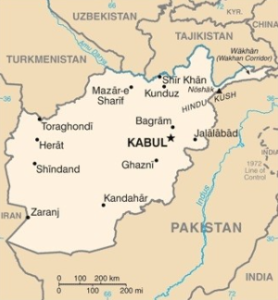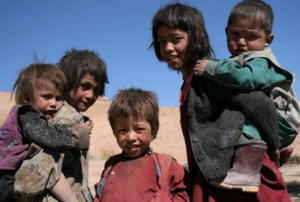 Afghanistan is a South Asian country that borders Tajikistan, Pakistan, Turkmenistan, Uzbekistan, Iran, and China. Over 85% of Afghanistan’s population are Sunni Muslims. There has been longstanding tension between the Sunnis and the Shia minority.
Afghanistan is a South Asian country that borders Tajikistan, Pakistan, Turkmenistan, Uzbekistan, Iran, and China. Over 85% of Afghanistan’s population are Sunni Muslims. There has been longstanding tension between the Sunnis and the Shia minority.
 The Hazaras are a Shia ethnic minority in Afghanistan, and they have faced discrimination for centuries. Before the 19th century, Hazaras made up nearly 67% of Afghanistan’s population. After decades of state-sponsored persecution, they now represent about 9 percent.
The Hazaras are a Shia ethnic minority in Afghanistan, and they have faced discrimination for centuries. Before the 19th century, Hazaras made up nearly 67% of Afghanistan’s population. After decades of state-sponsored persecution, they now represent about 9 percent.
The Taliban terrorist organization in Afghanistan practices a radical version of Sunni Islam. Taliban members do not believe in women’s rights and persecute intellectuals, activists, political dissidents, and Shia Muslims. They reserve a special hatred for Hazaras due to Hazaras’ ethnicity, religious practice, and perceived progressive culture.
 The Taliban was founded in the early 1990s and was backed by the CIA to fight Soviet occupation. The organization became popular based on promises to impose stability and law after years of conflict. It controlled most of Afghanistan from 1996 to 2001, backed financially by Pakistan.
The Taliban was founded in the early 1990s and was backed by the CIA to fight Soviet occupation. The organization became popular based on promises to impose stability and law after years of conflict. It controlled most of Afghanistan from 1996 to 2001, backed financially by Pakistan.
On September 11, 2001, Al-Qaeda perpetrated the 9/11 attacks on the United States. Al Qaeda leader Osama bin Laden was presumed to be in Afghanistan. President George Bush authorized force against those responsible for 9/11, which led to the U.S. invasion of Afghanistan to search for Bin Laden – who was ultimately found in Pakistan and killed. The U.S. invasion dislodged the Taliban from power and helped to install a civilian government.
For the next two decades, the U.S. tried unsuccessfully to quell Taliban resistance. Over 47,000 civilians, 6,000 U.S. troops, 1,100 NATO troops, 73,000 Afghan troops, and tens of thousands of Taliban fighters, were killed in the war. The Taliban persevered because of massive revenue streams from poppy cultivation, heroin trafficking, extortion, the mining of minerals and precious stones, and foreign funding. The Taliban earns anywhere from $300 million to $1.6 billion annually, money used for weapons and military support.
Taliban attacks on civilians increased significantly in 2020. Nevertheless, the Trump administration signed a preliminary peace deal with the Taliban. President Biden restated the U.S. intention to pull out of Afghanistan after the 2020 presidential election and committed to withdrawing all U.S. troops by September 11, 2021.
 The Hazaras have long faced state-sanctioned persecution in Afghanistan. They have been subjected to ethnic cleansing, slavery, land grabs, looting, and the pillaging of homes. Since the inception of the Taliban, the Hazaras have faced an acute threat of annihilation.
The Hazaras have long faced state-sanctioned persecution in Afghanistan. They have been subjected to ethnic cleansing, slavery, land grabs, looting, and the pillaging of homes. Since the inception of the Taliban, the Hazaras have faced an acute threat of annihilation.

Hazara Children in central Afghanistan. Image by Nasim Fekrat| Attribution-ShareAlike 4.0 International (CC BY-SA 4.0) | License
The most marked event in the Taliban’s persecution of Hazaras was the massacre in Mazar-I Sharif. On August 8, 1998. The Taliban captured the city, which had a large Hazara population. Invading troops did not discriminate between armed forces and innocent civilians. Taliban forces shot everything that moved. Over the next few days, Taliban fighters systematically persecuted ethnic minorities in the city. Hazaras were targeted most intensely. They were slaughtered, raped, sold into slavery, or forcibly converted to Sunni Islam. Estimates of the death toll range from 2,000 to 20,000.
Taliban terrorists have killed thousands of Hazaras in attacks over past decades. Hazaras have been massacred at schools, weddings, mosques, and hospitals across the country. In 2016, 85 unarmed civilians were slaughtered at a peaceful Hazara protest. In 2017, 41 civilians died in the bombing of a Hazara neighborhood in Kabul. In 2021, 90 students were killed in an attack on a Hazara girls’ school.
Hazaras have also been persecuted by other groups. The Islamic State’s affiliate in Afghanistan has declared war on Shia Muslims since 2014. The Afghan civilian government of 2001-2021 failed to protect Hazaras from terrorist attacks. They made the cold calculation that Hazara lives are expendable and not worth the cost of security efforts. Government-linked warlords are even behind some of the assaults.
 In 2021, the situation for Hazaras in Afghanistan is increasingly perilous. The country is facing COVID-19, drought, a dire economy, and destruction from the U.S. war. Now, the Taliban is again in control of Afghanistan’s government and institutions.
In 2021, the situation for Hazaras in Afghanistan is increasingly perilous. The country is facing COVID-19, drought, a dire economy, and destruction from the U.S. war. Now, the Taliban is again in control of Afghanistan’s government and institutions.
When U.S. troops began to withdraw, the Taliban launched an aggressive offensive. They quickly took control of every major city in the country. China is likely to recognize the Taliban’s leadership and to replace U.S. influence in Afghanistan. A Taliban government with close ties to China could represent a major issue for U.S. foreign policy. Another imminent threat is that the Taliban could offer increased protections for Al-Qaeda and other similar groups in Afghanistan as a launching point for international terrorism.
With the Taliban in power, intellectuals and activists are being persecuted. Women face a life without education, employment, or autonomy. Hazaras are at risk of annihilation. Thousands of civilians are desperate to flee the country, yet many states have closed their doors to the refugees. Civilians are in grave danger and require immediate humanitarian aid.
Updated 2021
References
“Afghan Hazaras being killed at school, play, even at birth.” https://apnews.com/article/islamic-state-group-shootings-05612533bbcbfa2d836d46d84b82ee92
“Afghan Hazaras Fear Taliban Gains.” https://www.genocidewatch.com/single-post/scarred-by-may-school-bombing-afghanistan-s-hazaras-fear-what-awaits-them-as-taliban-gains-ground
“Afghanistan.” https://www.cia.gov/the-world-factbook/countries/afghanistan/#geography
“Afghanistan: How does the Taliban make money?” https://www.bbc.com/news/world-46554097
“Afghanistan Live Updates: Fear Spreads in Kabul as Taliban Take Charge.” https://www.nytimes.com/live/2021/08/16/world/taliban-afghanistan-news?name=styln-afghanistan®ion=TOP_BANNER&block=storyline_menu_recirc&action=click&pgtype=LegacyCollection&variant=show&is_new=false
“Afghanistan: Massacre in Mazar-I Sharif.” https://www.hrw.org/legacy/reports98/afghan/Afrepor0.htm
“Afghanistan Population 2021 (Live).” https://worldpopulationreview.com/countries/afghanistan-population
“Afghan women forced from banking jobs as Taliban take control.” https://www.reuters.com/world/asia-pacific/afghan-women-bankers-forced-roles-taliban-takes-control-2021-08-13/
“China moves quickly to replace America in Afghanistan.” https://thehill.com/opinion/national-security/565460-china-moves-quickly-to-replace-america-in-afghanistan?rl=1
“China seeks to expand belt and road to Afghanistan in name of security as US withdraws troops.” https://www.scmp.com/news/china/diplomacy/article/3136112/china-seeks-expand-belt-and-road-afghanistan-name-security-us
“Genocide Emergency: Afghanistan, August 2021.” https://www.genocidewatch.com/afghanistan
“Hazaras.” https://minorityrights.org/minorities/hazaras/
“Kabul neighbourhood, home to Hazaras, stunned by wave of attacks.” https://www.aljazeera.com/news/2021/6/13/anger-as-afghanistan-mourns-death-of-car-blast-victims
“School Attacks on Afghanistan’s Hazaras Are Only the Beginning.” https://thediplomat.com/2021/05/school-attacks-on-afghanistans-hazaras-are-only-the-beginning/
“Taliban Control 65% of Afghanistan, EU official says.” https://www.genocidewatch.com/single-post/taliban-control-65-of-afghanistan-eu-official-says-after-series-of-sudden-gains
“The Hazara Genocide and Systemic Discrimination in Afghanistan” https://civilrights.org/blog/the-hazara-genocide-and-systemic-discrimination-in-afghanistan/
“The Latest on Afghanistan.” https://www.cnn.com/world/live-news/afghanistan-taliban-us-news-08-16-21/index.html
“The Taliban in Afghanistan.” https://www.cfr.org/backgrounder/taliban-afghanistan
“The U.S. War in Afghanistan, 1999-2021.” https://www.cfr.org/timeline/us-war-afghanistan
“The U.S. withdrawal from Afghanistan has encouraged the Taliban to stake their future on the battlefield, Stanford scholar says.” https://news.stanford.edu/2021/07/19/whats-next-afghanistan/
“‘Why Do We Deserve to Die?’ Kabul’s Hazaras Bury Their Daughters.” https://www.nytimes.com/2021/05/09/world/europe/afghanistan-school-attack-hazaras.html



